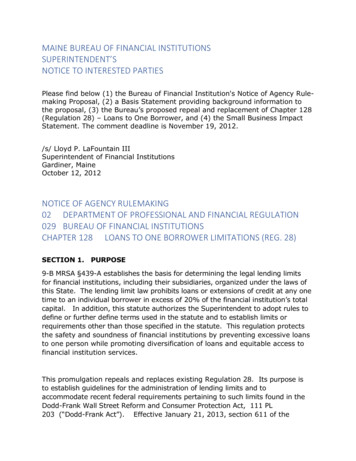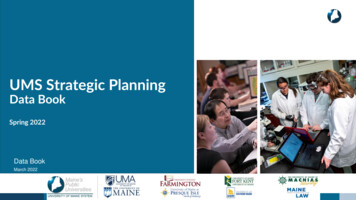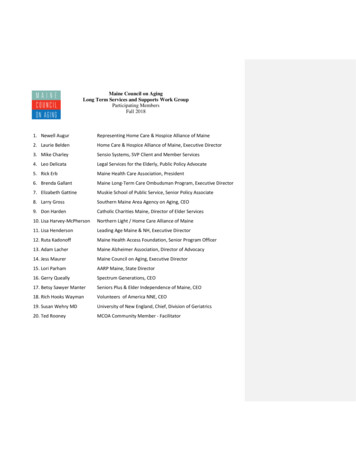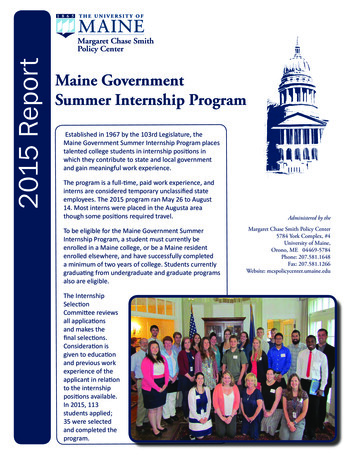
Transcription
MAINE BUREAU OF FINANCIAL INSTITUTIONSSUPERINTENDENT’SNOTICE TO INTERESTED PARTIESPlease find below (1) the Bureau of Financial Institution's Notice of Agency Rulemaking Proposal, (2) a Basis Statement providing background information tothe proposal, (3) the Bureau’s proposed repeal and replacement of Chapter 128(Regulation 28) – Loans to One Borrower, and (4) the Small Business ImpactStatement. The comment deadline is November 19, 2012./s/ Lloyd P. LaFountain IIISuperintendent of Financial InstitutionsGardiner, MaineOctober 12, 2012NOTICE OF AGENCY RULEMAKING02 DEPARTMENT OF PROFESSIONAL AND FINANCIAL REGULATION029 BUREAU OF FINANCIAL INSTITUTIONSCHAPTER 128 LOANS TO ONE BORROWER LIMITATIONS (REG. 28)SECTION 1. PURPOSE9-B MRSA §439-A establishes the basis for determining the legal lending limitsfor financial institutions, including their subsidiaries, organized under the laws ofthis State. The lending limit law prohibits loans or extensions of credit at any onetime to an individual borrower in excess of 20% of the financial institution’s totalcapital. In addition, this statute authorizes the Superintendent to adopt rules todefine or further define terms used in the statute and to establish limits orrequirements other than those specified in the statute. This regulation protectsthe safety and soundness of financial institutions by preventing excessive loansto one person while promoting diversification of loans and equitable access tofinancial institution services.This promulgation repeals and replaces existing Regulation 28. Its purpose isto establish guidelines for the administration of lending limits and toaccommodate recent federal requirements pertaining to such limits found in theDodd-Frank Wall Street Reform and Consumer Protection Act, 111 PL203 (“Dodd-Frank Act”). Effective January 21, 2013, section 611 of the
Dodd-Frank Act will prohibit state-chartered financial institutions from engagingin derivative transactions unless state lending limit laws take into considerationcredit exposure to derivative transactions. Prior to this promulgation, Maine’slending limit law did not provide guidance for measuring credit exposure arisingfrom derivative transactions. This promulgation addresses the Dodd-Frank Actrequirements by providing methods for taking into consideration creditexposure to derivative transactions for Maine’s financial institutions. Thispromulgation is based on the new interim final rule that was issued by theOffice of the Comptroller of the Currency (OCC) in response to the Dodd-FrankAct. This new interim final rule, which amends 12 CFR Part 32, may be foundat 77 FR 37265. Pursuant to this interim final rule, national banks must alsoevaluate credit exposure to derivatives transactions when calculating lendinglimits to a single borrower.Credit unions have lending limit requirements other than those found in theregulation.SECTION 2.AUTHORITYTitle 9-B MRS §215 authorizes the Superintendent to implement by rule anyprovisions of law relating to the supervision of financial institutions.Title 9-B MRS §439-A(5) authorizes the Superintendent to adopt rules to carryout purposes of the Banking Code’s lending limit law, including rules to define orfurther define terms used in the section and to establish limits or requirementsother than those specified in the section if the Superintendent determines thatsuch action is necessary for the protection of depositors, investors or the public.SECTION 3.1.DEFINITIONS“Borrower” means a person who is named as a borrower or debtor ina loan or extension of credit; a person to whom a financial institutionhas credit exposure arising from a derivative transaction entered bythe financial institution; or any other person, including a drawer,endorser, or guarantor, who is deemed to be a borrower under the“direct benefit” or the “common enterprise” tests set forth in section6 of this regulation.
2.“Contractual commitment to advance funds”:A.Includes a financial institution’s obligation to:(1)(2)(3)(4)Make payment (directly or indirectly) to a third personcontingent upon default by a customer of the financialinstitution in performing an obligation and to make suchpayment in keeping with the agreed upon terms of thecustomer's contract with the third person, or to makepayments upon some other stated condition;Guarantee or act as surety for the benefit of a person;Advance funds under a qualifying commitment to lend,that is, a legally binding written commitment to lendthat, when combined with all other outstanding loansand qualifying commitments to a borrower, is within thefinancial institution’s lending limit when entered into,and has not be disqualified; andAdvance funds under a standby letter of credit as definedin subsection 3(13) of this regulation, a put, or othersimilar arrangement.B. The term does not include commercial letters of credit and similarinstruments where the issuing financial institution expects thebeneficiary to draw on the issuer, that do not guarantee payment,and that do not provide for payment in the event of a default bya third party.3.4.“Control” is presumed to exist when a person directly or indirectly,or acting through or together with one or more persons:A.Owns, controls, or has the power to vote 25 percent or more ofany class of voting securities of another person;B.Controls, in any manner, the election of a majority of thedirectors, trustees, or other persons exercising similar functionsof another person; orC.Has the power to exercise a controlling influence over themanagement or policies of another person.“Credit derivative” means a financial contract executed understandard industry credit derivative documentation that allows oneparty (the protection purchaser) to transfer the credit risk of one or
more exposures (reference exposure) to another party (theprotection provider).5.“Derivative transaction” includes any transaction that is a contract,agreement, swap, warrant, note, or option that is based, in whole orin part, on the value of, any interest in, or any quantitative measureor the occurrence of any event relating to, one or more commodities,securities, currencies, interest or other rates, indices, or otherassets.6.“Eligible credit derivative” means a single-name credit derivative ora standard, non-tranched index credit derivative provided that:A.The derivative contract meets the requirements of an eligibleguarantee, as defined in subsection 3(7) of this regulation andhas been confirmed by the protection purchaser and theprotection provider;B.Any assignment of the derivative contract has been confirmedby all relevant parties;C.If the credit derivative is a credit default swap, the derivativecontract includes the following credit events:(1)(2)D.Failure to pay any amount due under the terms of thereference exposure, subject to any applicable minimalpayment threshold that is consistent with standardmarket practice and with a grace period that is closelyin line with the grace period of the reference exposure;andBankruptcy, insolvency, or inability of the obligor on thereference exposure to pay its debts, or its failure oradmission in writing of its inability generally to pay itsdebts as they become due and similar events;The terms and conditions dictating the manner in which thederivative contract is to be settled are incorporated into thecontract;
7.E.If the derivative contract allows for cash settlement, thecontract incorporates a robust valuation process to estimateloss with respect to the derivative reliably and specifies areasonable period for obtaining post-credit event valuations ofthe reference exposure;F.If the derivative contract requires the protection purchaser totransfer an exposure to the protection provider at settlement,the terms of at least one of the exposures that is permitted tobe transferred under the contract provides that any requiredconsent to transfer may not be unreasonably withheld; andG.If the credit derivative is a credit default swap, the derivativecontract clearly identifies the parties responsible fordetermining whether a credit event has occurred, specifies thatthis determination is not the sole responsibility of theprotection provider, and gives the protection purchaser theright to notify the protection provider of the occurrence of acredit event.“Eligible guarantee” means a guarantee that:A.Is written and unconditional;B.Covers all or a pro rata portion of all contractual payments ofthe obligor on the reference exposure;C.Gives the beneficiary a direct claim against theprotection provider;D.Is not unilaterally cancelable by the protection provider forreasons other than the breach of the contract by thebeneficiary;E.Is legally enforceable against the protection provider in ajurisdiction where the protection provider has sufficient assetsagainst which a judgment may be attached and enforced;F.Requires the protection provider to make payment to thebeneficiary on the occurrence of a default (as defined in theguarantee) of the obligor on the reference exposure in a timelymanner without the beneficiary first having to take legalactions to pursue the obligor for payment;
G.Does not increase the beneficiary's cost of credit protection onthe guarantee in response to deterioration in the credit qualityof the reference exposure; andH.Is not provided by an affiliate of the financial institution, unlessthe affiliate is an insured depository institution, bank,securities broker or dealer, or insurance company that:(1)(2)8.Does not control the financial institution; andIs subject to consolidated supervision and regulationcomparable to that imposed on U.S. depositoryinstitutions, securities broker-dealers, or insurancecompanies (as the case may be).“Eligible protection provider” means:A.A sovereign entity (a central government, including the U.S.government; an agency; department; ministry; or centralbank);B.The Bank for International Settlements, the InternationalMonetary Fund, the European Central Bank, the EuropeanCommission, or a multilateral development bank;C.A Federal Home Loan Bank;D.The Federal Agricultural Mortgage Corporation;E.A depository institution, as defined in section 3 of the FederalDeposit Insurance Act, 12 U.S.C. §1813(c);F.A bank holding company, as defined in section 2 of the BankHolding Company Act, as amended, 12 U.S.C. §1841;G.A savings and loan holding company, as defined in section 10of the Home Owners’ Loan Act, 12 U.S.C. §1467a;H.A securities broker or dealer registered with the SEC under theSecurities Exchange Act of 1934, 15 U.S.C. §78o et seq.;
I.An insurance company that is subject to the supervision of aState insurance regulator;J.A foreign banking organization;K.A non-U.S.-based securities firm or a non-U.S.-basedinsurance company that is subject to consolidated supervisionand regulation comparable to that imposed on U.S. insurancecompanies; andL.A qualifying central counterparty, for example, a clearinghouse that:(1)(2)(3)Facilitates trades between counterparties in one or morefinancial markets by either guaranteeing trades ornovating contracts;Requires all participants in its arrangements to be fullycollateralized on a daily basis; andThe bank demonstrates to the satisfaction of the Bureauthat it is in sound financial condition and is subject toeffective oversight by a national supervisory authority.9."Financial institution" has the same meaning that is set forth in 9-BMRSA §131(17).10."Loans or extensions of credit" has the same meaning that is set forthin 9-B MRSA §439-A(1)(A)A. “Loans or extensions of credit” include:(1)(2)(3)(4)Any credit exposure, as determined pursuant to section8 of this regulation, arising from a derivativetransaction;A contractual commitment to advance funds;An overdraft, whether or not prearranged, but not anintraday overdraft for which payment is received beforethe close of business of the financial institution thatmakes the funds available;The sale of Federal funds with a maturity of more thanone business day, but not Federal funds with a maturity
(5)B.of one day or less or Federal funds sold under acontinuing contract; andLoans or extensions of credit that have been charged offon the books of the financial institution in whole or inpart, unless the loan or extension of credit:(a)Is unenforceable by reason of discharge inbankruptcy;(b)Is no longer legally enforceable because ofexpiration of the statute of limitations or a judicialdecision; or(c)Is no longer legally enforceable for other reasons,provided that the financial institution maintainssufficient records to demonstrate that the loan isunenforceable.In addition to the exclusions from limitations found in 9-BMRSA §439-A(3), the following items do not constitute “loansor extensions of credit” for purposes of this regulation:(1)(2)(3)(4)Additional funds advanced for the benefit of a borrowerby a financial institution for payment of taxes, insurance,utilities, security, and maintenance and operatingexpenses necessary to preserve the value of realproperty securing the loan, consistent with safe andsound banking practices, but only if the advance is forthe protection of the financial institution’s interest in thecollateral, and provided that such amounts must betreated as an extension of credit if a new loan orextension of credit is made to the borrower;Accrued and discounted interest on an existing loan orextension of credit, including interest that has beencapitalized from prior notes and interest that has beenadvanced under terms and conditions of a loanagreement;Financed sales of a financial institution’s own assets,including Other Real Estate Owned, if the financing doesnot put the financial institution in a worse position thanwhen the financial institution held title to the assets;A renewal or restructuring of a loan as a new ‘‘loan orextension of credit,’’ following the exercise by a financialinstitution of reasonable efforts, consistent with safe andsound banking practices, to bring the loan intoconformance with the lending limit, unless new funds areadvanced by the financial institution to the borrower, ora new borrower replaces the original borrower, or unlessthe Bureau determines that a renewal or restructuring
(5)(6)was undertaken as a means to evade the financialinstitution’s lending limit;Amounts paid against uncollected funds in the normalprocess of collection;(a)That portion of a loan or extension of creditsold as a participation by a financial institution ona nonrecourse basis, provided that theparticipation results in a pro rata sharing of creditrisk proportionate to the respective interests ofthe originating and participating lenders. Where aparticipation agreement provides that repaymentmust be applied first to the portions sold, a prorata sharing will be deemed to exist only if theagreement also provides that, in the event of adefault or comparable event defined in theagreement, participants must share in allsubsequent repayments and collections inproportion to their percentage participation at thetime of the occurrence of the event.(b)When an originating financial institution funds theentire loan, it must receive funding from theparticipants before the close of business of its nextbusiness day. If the participating portions are notreceived within that period, then the portionsfunded will be treated as a loan by the originatingfinancial institution to the borrower. If the portionsso attributed to the borrower exceed theoriginating financial institution’s lending limit, theloan may be treated as nonconforming subject tosection 7 of this regulation, rather than aviolation, if:(i)The originating financial institution had avalidandunconditionalparticipationagreement with a participant or participantsthat was sufficient to reduce the loan towithin the originating financial institution’slending limit;(ii)The participant reconfirmed its participationand the originating financial institution hadno knowledge of any information that wouldpermit the participant to withhold itsparticipation; and(iii)The participation was to be funded by closeof business of the originating financialinstitution’s next business day; and
(7)Intraday credit exposures arising from a derivativetransaction.11."Perpetual preferred stock" means preferred stock that does not havea stated maturity date and cannot be redeemed at the option of theholder.12."Person" has the meaning as defined in 9-B MRSA §131(30).13."Standby letter of credit" is any letter of credit, or similararrangement, however named or described, which represents anobligation to the beneficiary on the part of the issuer:A.To repay money borrowed by or advanced to or for the accountof the account party;B.To make payment on account of any indebtedness undertakenby the account party; orC.To make payment on account of any default by the accountparty in the performance of an obligation.14."Subsidiary" has the meaning as defined in 9-B MRSA §131(39-A). A"service corporation," as defined in 9-B MRSA §131(37), is a"subsidiary" for the purposes of this regulation.15."Total capital and surplus" means:A.A financial institution’s Tier 1 and Tier 2 capital calculated underthe risk-based capital standards applicable to the institution asreported in the financial institution’s Consolidated Reports ofCondition and Income (Call Report); plus
B.SECTION 4.The balance of a financial institution’s allowance for loan andlease losses not included in the financial institution’s Tier 2capital, for purposes of the calculation of risk-based capitaldescribed in paragraph (A) of this subsection, as reported in thefinancial institution’s Call Report.LENDING LIMITSExcept as provided in 9-B MRSA §439-A and this regulation, a financial institutionand/or its subsidiaries may not make loans or extensions of credit outstanding atone time to a borrower in excess of 20% of its total capital and surplus.SECTION 5.CALCULATION DATE OF LENDING LIMITS1.Calculation date. For purposes of determining compliance with thisregulation, a financial institution shall determine its lending limit onthe last day of the preceding calendar quarter, unless otherwisedirected by the Superintendent.2.Effective date. A financial institution’s lending limit calculated inaccordance with subsection (1) of this section will be effective as ofthe earlier of the date on which the financial institution’s ConsolidatedReports of Condition and Income (Call Report) is submitted or the datethe Call Report is required to be submitted.SECTION 6. COMBINATION RULES1.General rule. Loans or extensions of credit to one borrower will beattributed to another person and each person will be deemed aborrower:A.When proceeds of a loan or extension of credit are to be usedfor the direct benefit of the other person, to the extent of theproceeds so used; orB.When a common enterprise is deemed to exist between thepersons.
2.Direct benefit. The proceeds of a loan or extension of credit to aborrower will be deemed to be used for the direct benefit of anotherperson and will be attributed to the other person when the proceeds,or assets purchased with the proceeds, are transferred to anotherperson, other than in a bona fide arm's length transaction where theproceeds are used to acquire property, goods, or services.3.Common enterprise. A common enterprise will be deemed to existand loans to separate borrowers will be aggregated:A.When the expected source of repayment for each loan orextension of credit is the same for each borrower and neitherborrower has another source of income from which the loan(together with the borrower's other obligations) may be fullyrepaid. An employer will not be treated as a source ofrepayment under this section because of wages and salariespaid to an employee, unless the standards of paragraph 3(B)of this section are met;B. When loans or extensions of credit are made:(1)(2)C.To borrowers who are related directly or indirectlythrough common control, including where one borroweris directly or indirectly controlled by another borrower;andSubstantial financial interdependence exists between dence is deemed to exist when 50 percent ormore of one borrower's gross receipts or grossexpenditures (on an annual basis) are derived fromtransactions with the other borrower. Gross receipts company loans, dividends, capital contributions,and similar receipts or payments;When separate persons borrow from a financial institution toacquire a business enterprise of which those borrowers willown more than 50 percent of the voting securities or votinginterests, in which case a common enterprise is deemed toexist between the borrowers for purposes of combining theacquisition loans;
D.When the Bureau determines, based upon an evaluation ofthe facts and circumstances of particular transactions, that acommon enterprise exists.4.Loans to corporations. For purposes of this regulation and 9-B MRSA§439-A, a corporation is a "subsidiary" of any person who directly orindirectly owns or beneficially owns more than 50% of the voting stockof the corporation. Loans or extensions of credit to a person and itssubsidiary or to subsidiaries of one person need not be combinedwhere the financial institution has determined that the person andsubsidiaries involved are not engaged in a "common enterprise" as thatterm is defined in subsection 3 of this section. Notwithstanding theforegoing sentence, loans or extensions of credit by a financialinstitution to a "corporate group" (defined as a person and all of itssubsidiaries) may not exceed 50% of the financial institution's totalcapital and surplus.5.Loans to partnerships, joint ventures, and associations.A.Loans or extensions of credit to a partnership, joint venture, orassociation shall, for purposes of this regulation, be consideredloans or extensions of credit to each member of suchpartnership, joint venture, or association.B.Paragraph (5)(A) of this section is not applicable to limitedpartners in limited partnerships or to members of joint venturesor associations if such partners or members, by the terms of thepartnership or membership agreement are not to be held liablefor the debts or actions of the partnership, joint venture, orassociation. However, the rules set forth in subsections 6(1),(2) and (3) of this regulation are applicable to such partners ormembers.C.Loans or extensions of credit to members of a partnership, jointventure, or association shall, for purposes of this regulation, beattributed to the partnership, joint venture, or association whereone or more of the tests set forth in subsections 6(2) and 6(3)of this regulation is satisfied with respect to one or more suchmembers. However, loans to members of a partnership, jointventure, or association will not be attributed to other membersof the partnership, joint venture, or association under thisregulation unless one or more of the tests set forth in
subsections 6(2) and (3) of this regulation is satisfied withrespect to such members.D.The tests set forth in subsections 6(2) and (3) of this regulationshall be deemed satisfied when loans or extensions of credit aremade to members of a partnership, joint venture, or associationfor purposes of purchasing an interest in such partnership, jointventure, or association.SECTION 7: NONCONFORMING LOANS AND EXTENSIONS OF CREDIT1.A loan or extension of credit, within a financial institution’s legallending limit when made, will not be deemed a violation but will betreated as nonconforming if the loan or extension of credit is nolonger in conformity with the financial institution’s lending limitbecause:A.The financial institution’s capital has declined, borrowers havesubsequently merged or formed a common enterprise, lendershave merged, or the lending limit or capital rules havechanged;B.Collateral securing the loan to satisfy the requirements of alending limit exception has declined in value.2.A financial institution must use reasonable efforts to bring a loan orextension of credit that is nonconforming as a result of paragraph1(A) of this section into conformity with the financial institution’slending limit unless to do so would be inconsistent with safe andsound banking practices.3.A financial institution must bring a loan that is nonconforming as aresult of circumstances described in paragraph 1(B) of this sectioninto conformity with the financial institution’s lending limit within 30calendar days, except when judicial proceedings, regulatory actionsor other extraordinary circumstances beyond the financialinstitution’s control prevent it from taking action.SECTION 8: CREDIT EXPOSURE ARISING FROM DERIVATIVETRANSACTIONS
1.Scope. This section sets forth the rules for calculating the creditexposure arising from a derivative transaction entered into by afinancial institution for purposes of determining the financialinstitution’s lending limit pursuant to this regulation.2.Derivative transactionsA.Non-Credit Derivatives. Subject to paragraph 2(B) of thissection, a financial institution shall calculate the creditexposure to a counterparty arising from a derivativetransaction by one of the following methods. A financialinstitution shall use the same method for calculatingcounterparty credit exposure arising from all of its derivativetransactions.(1)Conversion Factor Matrix Method. The credit exposurearising from a derivative transaction under theConversion Factor Matrix Method shall equal and remainfixed at the potential future credit exposure of thederivative transaction as determined at the execution ofthe transaction by reference to Table 1 below.TABLE 1—CONVERSION FACTOR MATRIX FOR CALCULATING POTENTIAL FUTURE CREDITEXPOSURE.[1]Original maturity[2]1 year or less Over 1 to 3 years Over 3 to 5 years Over 5 to 10years Over ten years ncludescommodities andprecious metalsexcept xchangerate andgoldEquityFor an OTC derivative contract with multiple exchanges of principal, the conversion factor is multiplied by thenumber of remaining payments in the derivative contract.2For an OTC derivative contract that is structured such that on specified dates any outstanding exposure is settled andthe terms are reset so that the market value of the contract is zero, the remaining maturity equals the time until thenext reset date. For an interest rate derivative contract with a remaining maturity of greater than one year that meetsthese criteria, the minimum conversion factor is 0.005.3Transactions not explicitly covered by any other column in the Table are to be treated as “Other.”1
(2)Remaining Maturity Method. The credit exposure arisingfrom a derivative transaction under the RemainingMaturity Method shall equal the greater of zero or thesum of the current mark-to-market value of thederivative transaction added to the product of thenotional amount of the transaction, the remainingmaturity in years of the transaction, and a fixedmultiplicative factor determined by reference to Table 2,below.TABLE 2—REMAINING MATURITY FACTOR FOR CALCULATING CREDIT xchangerate andgoldEquityOther[4](includescommoditiesand preciousmetalsexcept gold)1.5%1.5%6%6%Credit Derivatives(1)(2)Notwithstanding paragraph 2(A) of this section, afinancial institution that uses the Conversion FactorMatrix Method or Remaining Maturity Method shallcalculate the counterparty credit exposure arising fromcredit derivatives entered by the financial institution byadding the net notional value of all protection purchasedfrom the counterparty on each reference entity.A financial institution shall calculate the credit exposureto a reference entity arising from credit derivativesentered by the financial institution by adding thenotional value of all protection sold on the referenceentity. However, the financial institution may reduce itsexposure to a reference entity by the amount of anyeligible credit derivative purchased on that referenceentity from an eligible protection provider.SECTION 9: AUTHORITY OF THE SUPERINTENDENT4Transactions not explicitly covered by any other column in the Table are to be treated as “Other.”
The Superintendent may require a financial institution to use the ConversionFactor Matrix Method or the Remaining Maturity Method to calculate the creditexposure of derivative transactions if the Superintendent finds that suchmethod is necessary to promote the safety and soundness of the financialinstitution.SECTION 10: EFFECTIVE DATE: January 1, 2013FISCAL IMPACT STATEMENTThis proposed regulation does not impose any cost on municipalities or counties.PRIMARY SOURCES OF INFORMATION RELIED UPONThe Bureau relies upon the following primary sources of information in developingthe proposed rule: The Federal Deposit Insurance Act, 12 USC §1828, asamended by section 611 of the Dodd-Frank Wall Street Reform and ConsumerProtection Act, 111 PL 203; and 12 CFR Part 32 (OCC Lending Limits regulation).For an OTC derivative contract with multiple exchanges of principal, theconversion factor is multiplied by the number of remaining payments in thederivative contract.[2]For an OTC derivative contract that is structured such that on specified datesany outstanding exposure is settled and the terms are reset so that the marketvalue of the contract is zero, the remaining maturity equals the time until thenext reset date. For an interest rate derivative contract with a remaining maturityof greater than one year that meets these criteria, the minimum conversion factoris 0.005.1 [3]Transactions not explicitly covered by any other column in the Table are tobe treated as “Other.”1 [4]Transactions not explicitly covered by any other column in the Table are tobe treated as “Other.”[1]
MAINE BUREAU OF FINANCIA
The Federal Agricultural Mortgage Corporation; E. A depository institution, as defined in section 3 of the Federal Deposit Insurance Act, 12 U.S.C. §1813(c); . L. A qualifying central counterparty, for example, a clearing house that: (1) Facilitates trades between counterparties in one or more financial markets by either guaranteeing trades .











